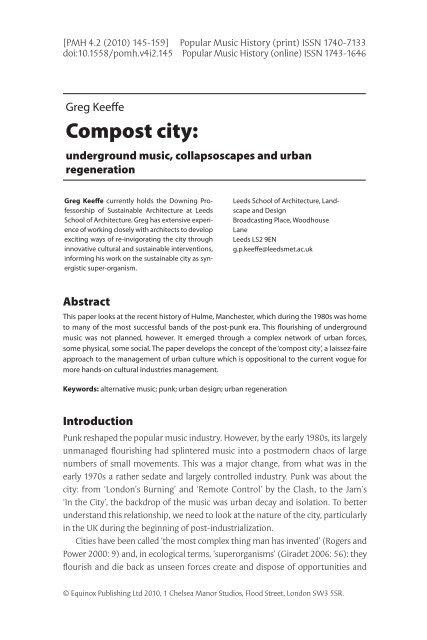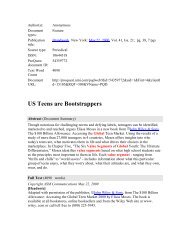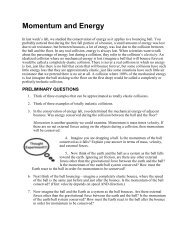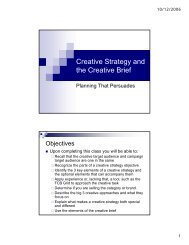Compost city: - MFC home page
Compost city: - MFC home page
Compost city: - MFC home page
You also want an ePaper? Increase the reach of your titles
YUMPU automatically turns print PDFs into web optimized ePapers that Google loves.
[PMH 4.2 (2010) 145-159] Popular Music History (print) ISSN 1740-7133doi:10.1558/pomh.v4i2.145 Popular Music History (online) ISSN 1743-1646Greg Keeffe<strong>Compost</strong> <strong>city</strong>:underground music, collapsoscapes and urbanregenerationGreg Keeffe currently holds the Downing Professorshipof Sustainable Architecture at LeedsSchool of Architecture. Greg has extensive experienceof working closely with architects to developexciting ways of re-invigorating the <strong>city</strong> throughinnovative cultural and sustainable interventions,informing his work on the sustainable <strong>city</strong> as synergisticsuper-organism.Leeds School of Architecture, Landscapeand DesignBroadcasting Place, WoodhouseLaneLeeds LS2 9ENg.p.keeffe@leedsmet.ac.ukAbstractThis paper looks at the recent history of Hulme, Manchester, which during the 1980s was <strong>home</strong>to many of the most successful bands of the post-punk era. This flourishing of undergroundmusic was not planned, however. It emerged through a complex network of urban forces,some physical, some social. The paper develops the concept of the ‘compost <strong>city</strong>’, a laissez-faireapproach to the management of urban culture which is oppositional to the current vogue formore hands-on cultural industries management.Keywords: alternative music; punk; urban design; urban regenerationIntroductionPunk reshaped the popular music industry. However, by the early 1980s, its largelyunmanaged flourishing had splintered music into a postmodern chaos of largenumbers of small movements. This was a major change, from what was in theearly 1970s a rather sedate and largely controlled industry. Punk was about the<strong>city</strong>: from ‘London’s Burning’ and ‘Remote Control’ by the Clash, to the Jam’s‘In the City’, the backdrop of the music was urban decay and isolation. To betterunderstand this relationship, we need to look at the nature of the <strong>city</strong>, particularlyin the UK during the beginning of post-industrialization.Cities have been called ‘the most complex thing man has invented’ (Rogers andPower 2000: 9) and, in ecological terms, ‘superorganisms’ (Giradet 2006: 56): theyflourish and die back as unseen forces create and dispose of opportunities and© Equinox Publishing Ltd 2010, 1 Chelsea Manor Studios, Flood Street, London SW3 5SR.
146 POPULAR MUSIC HISTORYsolutions. They are cybernetically controlled: their dynamics are the product of alarge number of interlinked simple and complex processes (Keeffe 2008: 4). This istrue of places of cultural production as well as trade. This paper describes one suchblooming, that of the Hulme district of Manchester during the 1980s, and creates ahypothesis about the dynamics of cultural blooming and its management.Hulme, Manchester: a biographyEarly beginningsThe Hulme district of Manchester was originally the site of a Roman temple dedicatedto Mithras, a cult believing in immortality favoured by the army. Whetherthis has any relevance may depend on your point of view, but there are very fewreferences to the place for another 1600 years, until the author Elizabeth Gaskelldescribed it thus in her seminal novel of early industrialization, Mary Barton(Gaskell 2006 [1848]: 12).There are some fields near Manchester, well known to the inhabitants as ‘GreenHeys Fields, Hulme’, through which runs a public footpath to a little villageabout two miles distant. In spite of these being flat and low, nay, in spite of thewant of wood (the great and usual recommendation of level tracts of land),there is a charm about them which strikes even the inhabitant of a mountainousdistrict, who sees and feels the effect of contrast in these common-placebut thoroughly rural fields, with the busy, bustling manufacturing town he leftbut half an hour ago. Here and there an old black and white farmhouse, with itsrambling outbuildings, speaks of other times and other occupations than thosewhich now absorb the population of the neighbourhood.Suffice to say, this idyll did not last much longer, as the busy manufacturing townbegan to grow beyond all expectations. Indeed by 1856 the population had reached1 million (Kidd 2005: 143), and as the population in Georgian times was as low as20,000, this created startling problems. Manchester, documented most eloquentlyby Engels in his The Condition of the Working Class in England in 1844 (Engels 2009[1844]) was the ‘Shock City’ of the Victorian age. The <strong>city</strong> had no City Council andlaissez-faire capitalism was at its most unfettered, creating industrial slums ofexceptional density around the <strong>city</strong>. In areas such as Angel Meadow on the edgeof the medieval <strong>city</strong> limits a scarcely believable 190,000 people crammed into acouple of acres of slums. Even then, Hulme was notorious: within a kilometre of the<strong>city</strong> centre, it had some of the worst living conditions of all, with new immigrantscrammed into tiny back-to-back terraces. This squalor is documented gruesomelyby J. P. Kay in his study of cholera outbreaks in Manchester:In some districts of the town, evils exist so remarkable as to require more minutedescription. A portion of low, swampy ground, liable to be frequently inundatedis included between a high bank over which the Oxford Road passes and a bend© Equinox Publishing Ltd 2010.
COMPOST CITY 147in the River Medlock, where its course is impeded by a weir. This unhealthyspot lies so low that the chimneys of its houses, some of them three storeyshigh are little above the level of the road. About two hundred of these habitationsare crowded together in an extremely narrow space, and they are chieflyinhabited by the lowest Irish. Many of these houses also have cellars, whosefloor is scarcely elevated above the level of the water flowing in the Medlock…The district has sometimes been the haunt of hordes of thieves and desperadoeswho defied the law, and is always inhabited by a class resembling savages intheir appetites and habits (Kay 1832: 47).Figure 1. Early growth of Hulme 1848–1909 © Digimap 2004 (edited by author)First redevelopmentAlthough such appalling conditions prevailed, very little new development tookplace in the district until four small blocks of the worst housing were redevelopedin the 1930s. Even Hitler’s Luftwaffe did not help, although a small number ofbombs did land here (Hayes 1993). By 1960, Hulme was rated by The Times in thebottom five council wards in the UK (HMSO 1995: 6), and thus, following the ideasset out in the Manchester Plan 1945, redevelopment was decided upon.The Manchester Plan 1945 (Nicholas 1945), developed during the war by plannersdetermined to make victory a beautiful socialist utopia, was very radical.Seeing no good in the cramped working-class dwellings, with no space, lightor greenery, they set out to undertake a complete rebuilding of the <strong>city</strong>, wherealmost no stone would be left unturned. Even Alfred Waterhouse’s masterpieceManchester Town Hall was to be demolished, so what hope the measly terraces ofHulme? The car was to be king, and with Hulme so close to the <strong>city</strong> centre, it wasto be obliterated by new grass- and tree-lined boulevards.For the modernization of the outline plan and detailed design of the estates, the<strong>city</strong> architects chose the award-winning modernists Wilson Wormersley Archi-© Equinox Publishing Ltd 2010.
148 POPULAR MUSIC HISTORYtects (who were also later to design the much-maligned Arndale Centre in the<strong>city</strong>). Their first task was the complete decanting of the unruly populous to newestates in outlying country villages such as Middleton, Knutsford and Macclesfield,a move that seems unimaginable now. This would be followed by wholesaledemolition. This uprooting of the populous created mayhem in the villages, andin the end, caused the destruction of the complex social structures of Hulme itself,which led to many of the severe problems of the modernist estate that followed.Nothing survived this ‘redevelopment’ except for four parish churches, a coupleof public houses and the 1930s redevelopment. It was a tabula rasa—a blank canvason which it would be possible to design a new socialist utopia. Thus Hulme began itsjumping trajectory, of total re-development followed by total demolition, which hasbeen repeated several times. Places with this sort of ‘demolition > re-build > demolition’trajectory have been dubbed by this author as ‘the collapsoscape’ (see below).Figure 2. Modernist Hulme circa 1980. Note the scale of the Crescents. ©Digimap 2004 (editedby author)© Equinox Publishing Ltd 2010.
COMPOST CITY 149This new development consisted of several estates (imaginatively named Hulme1–5) of apartments and maisonettes between three and eight storeys high. Therewas grade separation of cars and pedestrians, zoning of function, and a generalapplication of new technologies. In addition the district was severed North–Southby a new highway to the City Airport, which was cut into a giant ravine. Althoughthis was nothing like the Manchester of old, it did become a new ‘Shock City’: twoof the estates in particular, on either side of the fissure, captured the imaginationof the Mancunian populous as they raced by.One of these (Hulme 5) was the Crescents. Designed by Wilson Wormserley,it consisted of four crescent-shaped deck access blocks, one of which (John NashCrescent) was based on the proportions of the Royal Crescent in Bath. Each Crescentwas subsequently named, in a ridiculous act of hubris, after famous GeorgianArchitects—William Kent, Charles Barry, John Nash and Robert Adam. The monumentalscale and proportions of the Crescents were magnificent from a distance(they were seven storeys high in a <strong>city</strong> with suburbs of mainly two or three storeys,and their construction of washed concrete and primary coloured cementitiouspanels was in contrast to the soot-stained red brick of the remaining <strong>city</strong>).Figure 3. John Nash Crescent, Hulme (Steve Yates, MMU Slide Library)The second of these estates, Hulme 4, was developed by the City Architects andwas equally striking, consisting of grey steel, black and orange timber and glazedpanels. These buildings were of modular prefabricated construction, resemblinga giant lego set, and were known as the ‘Inca Dwellings’, due to their form resem-© Equinox Publishing Ltd 2010.
150 POPULAR MUSIC HISTORYbling that of Inca Temples. This nickname was popularized by Pat Pheonix, theactress better known as Elsie Tanner in the Mancunian soap opera CoronationStreet, who said in an interview, ‘There are things to save if they care to. We callthose Hulme flats “the Inca dwellings” ’ (Morrissey 1985).Figure 4. The Inca dwellings (Steve Yates, MMU Slide Library)Because of the wholesale demolition, and the fact that many other areas of the<strong>city</strong> had had a similar fate, the developments were rushed, both in design andconstruction. In addition, many of the building techniques employed were noveland untested: almost at once, even before the estates were finished, there wereserious problems, both technological and social. Technological problems weremainly due to the novel techniques employed, many of the modular systemsbeing poorly manufactured and not fitting together properly. For example, theflat I occupied between 1982 and 1988 (60 Elmin Walk) in the Inca dwellingshad panels that were not correctly fastened to the structural frame and swungoutwards in the breeze. The Crescents too suffered problems, particularly withregard to heating, where the uninsulated dense concrete frame sapped the heatthat blew asthmatically from an asbestos-clad, centralized, electric-powered,warm air heater under the stairs.Social problems too were widespread: the decanting of the original populousand their re-introduction had broken the social bonds that had bound themtogether. The blocks were anonymous and now no one knew their neighbours.In addition, the deck access blocks allowed thieves to escape as they could travel© Equinox Publishing Ltd 2010.
COMPOST CITY 151several kilometers without having to touch the ground. The separated transportstrategy created dangerous walkways that were unsurveyed by dwellers; in particularthe two pedestrian bridges that crossed the ravine enabled muggers toaccost unsuspecting pedestrians who dared to use them. The whole situation wasbrilliantly documented in a 1978 episode of the Granada television programmeWorld in Action, ‘No Place Like Hulme’, which stated that you were 30 times morelikely to be mugged or murdered in Hulme, than in an average place in the UK(Beckham 1978).The final straw for the City Council was when a young child managed to takethe cover off one of an array of innovative modular electri<strong>city</strong> substations andblow his arms off. The Council then banned families from living on the estate.This was the beginning of the end, as an estate with only single people is notsocially sustainable. Furthermore, it was not generally popular with tenants, andby 1980, less than ten years after the first flats were built (and less than five yearsafter the last was finished) most of the estate was empty, with less than one infive flats occupied.Hulme: 1980s re-occupationThis, however, is the beginning of the story, not the end. In the next five years therewas an incredible influx of young people into the flats, so that by 1985, nearlyevery apartment was occupied, or at least squatted.Figure 5. Typical public realm (Steve Yates, MMU Slide Library)© Equinox Publishing Ltd 2010.
152 POPULAR MUSIC HISTORYThe phoenix-like rising of Hulme started with the Factory Club. In 1978, FactoryRecords, set up by Tony Wilson, then a young television executive for GranadaTV with an interest in youth culture, and his co-conspirators Martin Hannett,Alan Erasmus and Rob Gretton, opened a night to showcase punk bands (manyof which were filmed for the Granada TV show Wilson fronted, So It Goes). At firstthese nights were held at a club on Oldham Road in Collyhurst to the north of the<strong>city</strong> known as the Osbourne Club. The club was successful, but the punks whowent to the nights found themselves being attacked by local ‘hoods’ when theyleft the premises. It was decided a new venue was needed, and the Russell Club inHulme was chosen.Built in the shadow of the Crescents, the Russell Club (later the PSV Club) wastenanted by the SELNEC bus drivers’ social club and was popular with Jamaicanimmigrants (some of whom were bus drivers), and often featured bands—mainlyreggae acts such as the Twinkle Brothers. Once a week, the club would now showcasenew alternative bands, many of whom (e.g. Joy Division, A Certain Ratio, FranticElevators [featuring Mick Hucknall]) would go on to be internationally famous. Theproximity to this venue of a large amount of empty apartments was not unnoticed.Some of the first to take advantage of this were members of A Certain Ratio.Figure 6. Hulme Festival 1981. The modernist spaces were perfect for impromptu concertsA Certain Ratio were an industrial funk band, who were originally managed byWilson, and released a series of singles and cassettes on Factory which broughta modicum of success—the most famous of which was their cover of ‘Shack Up’(originally by Bambara) on a Belgian label Discques du Crespuscule. However,within the Manchester scene, they were major players, with Simon Topping,Martin Moscrop and Jez Kerr being style icons for a whole generation of Manchesterboys. So when a major interview of the band by the (then) influential PaulMorley appeared in the New Musical Express, hip kids took notice. The interviewtook place in a Hulme Crescent flat, and tied many references of the bleak postindustrialnoise to the bleak surroundings of Hulme (Morley 1980).© Equinox Publishing Ltd 2010.
COMPOST CITY 153In addition, Hulme was very close (within ten minutes walk) of the two ManchesterUniversities, and this with the rapid increase in student numbers in theearly 1980s and the lack of accommodation made Hulme the hippest address intown, and flats were easy to come by. A prospective tenant could choose a vacantflat and merely kick the door in, and then repair the lock, or perhaps cut throughthe ‘cardboard’ panelling and then patch up; sometimes doors were alreadyopen—swinging invitingly in the breeze. More honest tenants might go and queueat the Housing Office in nearby Moss Side, and then claim they were <strong>home</strong>less,and keys would be handed out on the spot with a new rentbook (which wouldnever be used).Thus between 1980 and 1982 an amazing transformation took place in thedecrepit estate, as flat after flat became occupied by a mixture of culturally activeyoung people and others on the fringe of society. It was a volatile mix, indeed aviolent one, but one that changed Manchester forever. The psycho-geographicalexcellence of the neighbourhood was completed when in 1982 the Haciendanightclub opened within 10 minutes walk of the Crescents.The area then became the cultural focus for the <strong>city</strong>, particularly for undergroundmusic; almost every band that the <strong>city</strong> produced during the late 1970suntil the early 1990s either lived or rehearsed there. Many of the flats had informalrehearsal spaces built into them by the new residents, often using elements suchas doors and carpets purloined from empty flats nearby. These bands then startedto brand Hulme (and then the City of Manchester more generally), and caused aneven larger influx of young people.As Hulme filled up, the number of bands increased, so that by the middle ofthe decade there were said to be upwards of 200 living in the concrete wilderness.Bands such as The Super Furry Animals moved from North Wales to Hulmeto be part of the scene and benefit from its branding. Gruff explained to JohnRobb (Interview for <strong>Compost</strong> Cities Exhibition, http://www.urbis.org.uk/<strong>page</strong>.asp?id=2934):‘So a bunch of us had moved up from North Wales and we squatted in a flatin Hulme, because the Hulme and Moss Side estates were getting ready fordemolition. So I lived there for about three years. We squatted somewhere fora bit and then we got a tenancy’. He sighs heavily. ‘I had three dark years there… Ihad to move around within the estate’, he explains. ‘It was a very heavy area anda heavy point in time. Manchester City Council had rent amnesties occasionallybecause they’re quite a progressive council. But the first house I lived in wascompletely insane. It was more like a mental hospital, care in the community…It was…’ he struggles for the word, ‘…challenging. No, actually, it was a f**kingnightmare.’Hulme offered everything an aspiring post-punk band could need; as the guitaristof Big Flame explains, ‘As a band we loved practising. We built a practice room in© Equinox Publishing Ltd 2010.
154 POPULAR MUSIC HISTORYthe flats. I moved to Elmin Walk [Hulme 2] to get a room. I wandered round andfound an empty flat with an extra bedroom in it, so that’s where we rehearsed.We stapled carpets to the walls… Anyone who wanted to be in a band had loads ofspace in Hulme to do it’ (Robb 2009: 61).These bands ranged from the hip and obscure, like Big Flame (once named byJohn Peel as his favorite live band), to the popularist and establishment such asSimply Red. The list of bands who lived or rehearsed there is incredible. Some ofthe most famous include: the Stone Roses, Joy Division, A Certain Ratio, Kalima,James, Jazz Defectors, the Inca Babies, My American Wife, Tools You Can Trust,New Fast Automatic Daffodils, Ruthless Rap Assassins, 808 State, GrahameMassey, Super Furry Animals, Big Flame, M-People, Frantic Elevators, DislocationDance, Simply Red, among many others. Even some older artists, such as Nicofrom the Velvet Underground and Geno Washington, lived there.Figure 7. Hulme bands clockwise from top left: Tools You Can Trust; Mike from the Inca Babies atHulme Festival 1984; makeshift studio in Crescent flat; Dil from Big Flame at the Ardri Ballroom1983 (Source: Ian Ford)The mix of cultures was important too: there was a large West Indian communityin nearby Moss Side, and many Rastafarians lived in and around Hulme. The ex-Hacienda DJ Dave Haslam in John Robb’s seminal study of the Manchester sceneputs it very succinctly, ‘Pictures of Hulme in that era make it look like Blade Runnerafter the Blitz and that’s how it felt. It did feel like a unique landscape really, all© Equinox Publishing Ltd 2010.
COMPOST CITY 155these blocks were falling apart and they stank. It was dangerous to walk aroundbut you would hear great music from the windows: walk on a bit further it wouldbe a great dance record; walk a bit further and you would hear some kind of dub’(Robb 2008). Hulme now had a new duality both as a creative place and as a dangerousplace—the two being linked inextricably. Nick Blincoe’s novel Acid Casuals(Blincoe 1998) set around Hulme sums up the vibe:Down to the Mancunian Way, through the underpass with its strange cobbledhillocks…some sort of urban design feature…and up into Hulme. Junk walkedeverywhere. He kept his head down as he took his long stepping strides, hishands in the pockets of his snorkel jacket and his waterproof satchel dangling athis back. To his right, just out of sight, was his own flat. Beyond were the Crescents,the huge blocks that, uninhabitable or squatted, had lately been demolished.On the left, slung over Princess Park Way, was the narrow footbridgewhere gangs would wait at night to tax crossing pedestrians…. Closer to Hulme,the pulpy smell from the brewery had already begun to dull the morning’s edge.Junk crossed over a patch of green where the pitbulls played, and climbed thesteps at Elmin Walk, up to his own flat.The different musical cultures of Hulme started to cross-fertilize, and by the endof the decade a new music had evolved, fusing post-punk with elements of jazzfunk,electro, house and hip-hop. It was known as acid house, and the so-called‘Madchester’ style was born. This new music, tied with the new recreational drugEcstasy, created a new scene that echoed around the world, and by 1990 Manchesterwas the world’s number one music <strong>city</strong>. Madchester appeared on the cover ofthe July issue of Newsweek magazine (Foote 1990), the cover showing Hacienda DJand hairstylist Andrew Berry in an appropriate outfit, on a lurid pink background.This became an enduring image of Manchester. In the article within, an incredulousjournalist famously wrote:This dank industrial center, 185 miles north of London, was once known forhigh unemployment and sandwiches made of french fries and butter. NowManchester’s working class kids have become missionaries of a movementwhose influence is felt from Norway to Greece…1990s redevelopmentAs Madchester was taking off, moves were afoot in Central Government to dosomething about the apparently ungovernable areas of the UK’s post-industrialheartlands. The right-wing Conservative Government, faced with wide-scaleinner-<strong>city</strong> rioting in 1981, gave the Minister for the Environment Michael Heseltineextra powers to redevelop troublesome estates, which had become no-go areas.Hulme was one of them. Slowly but surely during the 1980s plans were drawn upto redevelop the estate, without really consulting with the punks etc. who now© Equinox Publishing Ltd 2010.
156 POPULAR MUSIC HISTORYFigure 8. Newsweek coverlived there. During the early 1990s whole swathes of the estate were emptied, andfinally in 1994 the Crescents themselves were demolished. The motives behind thiswere political: the Government were trying to create a <strong>home</strong>-owning populous inthe cities who would by default vote Conservative—but no one would ever buy aCrescent flat (although some did try).The young people and their cultures were summarily removed from Hulmeand a second new tabula rasa created. It was left to Mills Beaumont Leavy Architectsto create a new ‘European masterplan’ of roads and low-rise buildings,for the new <strong>home</strong> owners (Manchester City Council 1994). Hulme, the areathat had done so much to reinvent and rebrand Manchester as a post-industrialrenaissance was no longer, and so ended the incredible post-punk blooming ofthe <strong>city</strong>.© Equinox Publishing Ltd 2010.
COMPOST CITY 157<strong>Compost</strong>ing the <strong>city</strong>There are lessons to be learnt from this story, lessons that can be used to developnew models of culture, and its propagation in the <strong>city</strong>. The most important is thatcities are dynamic, living things, and that they and things in them bloom anddecay, and that this process is difficult, if not impossible to manage. The currentstrategy among <strong>city</strong> governors and urbanists is to try and create an arts quarter,built around some edifice such as a venue or centre. However, this generally fails,for two reasons: firstly that the venue is a charity, and eventually money runs out,and secondly because culture is an underground thing, and most players do notwant to be part of anything ‘official’, so go elsewhere. The author would suggesta different dynamic for the <strong>city</strong>, one of ‘composting’ (see <strong>Compost</strong> Cities, http://www.urbis.org.uk/<strong>page</strong>.asp?id=2934).The idea of composting is well-known to gardeners who use their waste toproduce new fertilizer, but less well-known in civic governance. The <strong>Compost</strong>City starts with the recognition that culture is an emergent phenomenon, andgenerally occurs in urban areas. These areas are spatial context and, as the cultureis emergent and thus place-based, then the spatial context ends up shaping theculture. This is obvious in Hulme and Manchester, where the post-industrial derelict<strong>city</strong> shaped and finally branded this music as ‘industrial’ and then as ‘ManchesterMusic’. It is also true of other places in other cities, for example, places thatbloomed during the same period such as Brixton, London, Kreuzberg, Berlin andLower East Side in New York, which developed their own place-based culture.This spatial context is difficult to design to suit changing culture, as the worldsof content and form are incommensurate. Although it may be possible to determinethe apparently perfect mix of classes and peoples, for a creative <strong>city</strong>, asRichard Florida suggests (Florida 2004), it is much more difficult to attract themto the area using architectural design. The reason for this is that the production ofarchitecture and its permanence is much slower in development than the culturethat it is responding to. This is put eloquently by the Dutch architect Rem Koolhaus:‘The areas of consensus shift unbelievably fast: the bubbles of certainty areconstantly exploding…increasingly there is a discrepancy between the accelerationof culture and the slowness of architecture’ (Fairs 2004). This slowness of productionof physical space in the <strong>city</strong> creates a time-lag, and this time-lag manifestsitself in redundant infrastructure.The new urban dynamic and its managementThe key to the process is that redundant <strong>city</strong> infrastructure decays very quickly,business and people move out and property prices decrease. This spatial dynamic© Equinox Publishing Ltd 2010.
158 POPULAR MUSIC HISTORYcreates an environment I have coined ‘the collapsoscape’ (Keeffe and Jefferiesforthcoming). In the collapsoscape, almost any new intervention is guaranteedto fail, as the economics of speculation are in reverse: new buildings depreciateinstead of appreciating when finished. This then creates an uncertain market thatquickens the decline. Eventually all that is left is decaying buildings at rock-bottomprices. This was certainly the case in Hulme, when in 1986, attempts were madeby the author to buy an apartment in the Hulme Crescents under the Government’s‘Right to Buy’ scheme, only to be thwarted when the valuer said the flathad no value whatsoever, and thus could not be sold! This ecology is perfect foralternative underground culture to grow, as creative people are generally on lowincomes and are short of money, and rents will be peppercorn. The place willbe colonized particularly quickly if the redundant infrastructure is within walkingdistance of the places of consumption in the <strong>city</strong>.Comsumption of culture is key for its propagation: the people who are earlyconsumers of this underground culture are of two types: firstly, those in rapture,young people, for example students from colleges and universities or dropoutsfrom them; and secondly, usually by general revulsion, the establishment. Thusthe area generally needs to be near or en-route to both these sectors’ zones in the<strong>city</strong>—for the first the university campus and secondly the Central Business District.This is important, particularly for visual arts, as the intended audience, both friendand foe, needs to be nearby.The use of this redundant space by alternative cultures ends its redundancyand the space is recontextualized and then rebranded as art/creative space. Thiscompletes the turnaround, as this sort of space is very popular with media typesand developers, because when rebranded, it creates a friendly street scene thatis good to inhabit. Now the area has new value, people begin to speculate, andthe area regenerates. Underground culture then moves on. This dynamic is seenclearly in Manchester with the later development of the Northern Quarter onceHulme had regenerated during the late 1990s and early 2000s.Redevelopment of the collapsoscape cannot be forced: like its collapse, itsresurgence is emergent too. The dynamic of composting needs to be adhered to.Firstly let the space collapse completely, socially and economically (this is almostimpossible to stop anyway). Then once the area is at the bottom of the market,cultural industries will bloom there without any incentive. There is no need tospring clean, or to hothouse culture with an Arts Centre; this sort of thing will bedeveloped as part of the new laissez-faire development of the neighbourhood:it just takes time. If the <strong>city</strong> is short of time, then there is no solution anyway—urban design and architecture are glacial in their effects, and there are no quickfixes.© Equinox Publishing Ltd 2010.
COMPOST CITY 159ReferencesBeckham, M. 1978. World in Action, ‘No Place Like Hulme’. Granada TV.Blincoe, N. 1998. Acid Casuals. London: Serpents Tail.Engels, F. 2009 [1844]. The Condition of the Working Class in England in 1844. London:Penguin.Fairs, M. 2004. ‘Rem Koolhaus’. Icon 013 (June): 68–78.Florida, R. 2004. Cities and the Creative Class. London: Routledge.Foote, J. 1990. ‘Stark Raving Madchester’. Newsweek, July 23: 62–3.Gaskell, M. 2006 [1848]. Mary Barton. Oxford: Oxford University Press.Giradet, H. 2006. Creating Sustainable Cities. London: Green Books.Hayes, C., ed. 1993. Our Blitz: Red Skies over Manchester. Bolton: Aurora.HMSO. 1995. Manchester: 50 Years of Change. London: HMSO.Kay, J. P. 1832. The Moral and Physical Conditions of the Working Classes Employed in CottonManufacture in Manchester. Manchester.Keeffe, G. P. 2008. Means Means Means: Adventures in the Technoscape. Manchester: MSAPress.Keeffe, G. P., and T. Jefferies. forthcoming 2011. Adventures in the Collapsoscape. CT Press.Kidd, A. 2005. Manchester: A History. London: Carnegie Publishing.Manchester City Council and Hulme Regeneration Limited. 1994. Rebuilding the City: A Guideto Development in Hulme. Manchester.Morley, P. 1980. ‘The Mancunian Candidates: A Certain Ratio Take the Soul Test’. NewMusical Express, September 6: 21–5.Morrissey, S. 1985. ‘Never Turn your Back on Mother Earth’. Blitz 31 (May): 9–12.Nicholas, R. 1945. The City of Manchester Plan. Manchester: Jarrold and Son.Robb, J. 2008. The North Will Rise Again: Manchester Music City 1976–1996. London: AurumPress.—2009. Death to Trad Rock. London: Cherry Red Books.Rogers, R., and A. Power. 2000. Cities for a Small Country. London: Faber and Faber.© Equinox Publishing Ltd 2010.
Copyright of Popular Music History is the property of Equinox Publishing Group and its content may not becopied or emailed to multiple sites or posted to a listserv without the copyright holder's express writtenpermission. However, users may print, download, or email articles for individual use.
Copyright of Popular Music History is the property of Equinox Publishing Group and its content may not becopied or emailed to multiple sites or posted to a listserv without the copyright holder's express writtenpermission. However, users may print, download, or email articles for individual use.





![Graduate Bulletin [PDF] - MFC home page - Appalachian State ...](https://img.yumpu.com/50706615/1/190x245/graduate-bulletin-pdf-mfc-home-page-appalachian-state-.jpg?quality=85)










